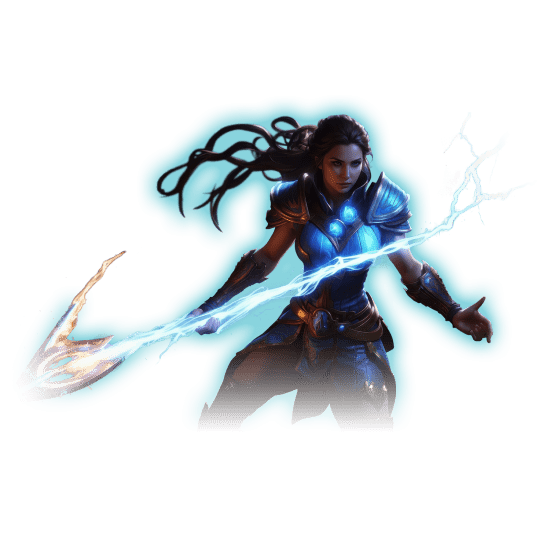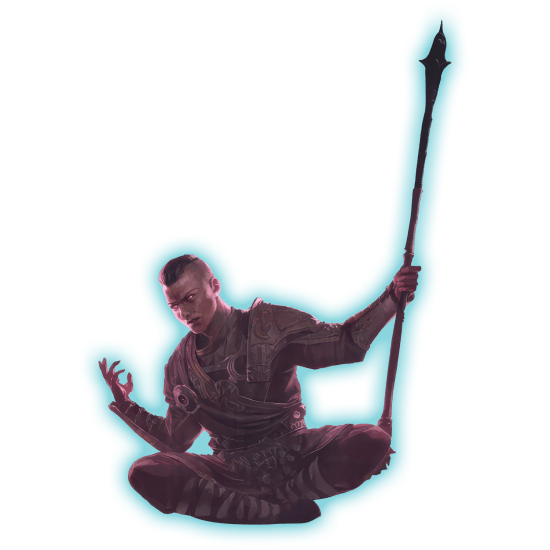Gather round, Exiles! This Path of Exile 2 Monk guide is dedicated to one of the most unique and exciting classes in PoE 2. The reason Monk has been added to the game along with other new classes is that a lot of the new gameplay mechanics that are now defined for PoE 2 didn’t fit any of the existing classes. So, new classes have had to be designed. As you will soon learn, Monk’s defining feature is mobility. This is the first movement-based class that incorporates dashes and movement-based attacks into his fighting style. In this guide, we’ll dive deeper into the Monk’s mechanics, explore his preferred weapon types, and talk about the gems, Ascendancies, leveling, and builds. We’re going to wrap things up with some Monk-related tips and tricks that will help you unlock this class’s full potential.
By the way, if you need professional help making an effective Monk build that will take you all the way through the acts and well into the endgame, you can Buy Monk Build service at Skycoach. You can choose between several options and specify what custom build you're going for, or allow the pros at Skycoach to make you the best build in the game. Skycoach has a rep sheet of providing similar services in the first game, so your character will be in good hands.
Read our other PoE 2 class guides:
Note: At Skycoach, you can Buy Path of Exile 2 Boost at the best prices with fast delivery. Use our special PROMO CODE (in green) hidden in this article for a 20% DISCOUNT.
PoE 2 Monk Overview
Monk is a Dexterity + Intelligence melee class that has lots of AoE and element-based abilities that help him keep his enemies at a safe distance. Most of Monk’s abilities and skills have some kind of mobility built into it. As a melee combatant, the Monk excels in mobility, precision, and adaptability, offering a dynamic and fluid playstyle that emphasizes agility and tactical use of unique mechanics. Here's an in-depth Path of Exile 2 Monk overview that highlights what makes this class unique.
Playstyle and Core Mechanics
- Mobility-Focused Melee Combat: The Monk's skills integrate movement into their attacks, allowing seamless repositioning during combat. This enhances the fluidity of melee engagements, making the class feel fast and reactive.
- Power Charge Synergy: A defining mechanic of the Monk is its interaction with power charges. Many Monk abilities gain enhanced effects when powered by these charges, creating a rhythm of generating charges and unleashing devastating attacks.
- Dodge Roll and Skill Cancellation: The Monk benefits from the Path of Exile 2 addition of a universal dodge roll, which provides a quick, responsive way to evade attacks. This feature can cancel ongoing animations, giving the Monk unparalleled control in combat.
To sum up, Monk’s gameplay is very mobile, and you’re constantly dancing around enemies, whether it’s a pack of lesser mobs or a boss, stacking charges to unleash powerful final blows. This is very similar to the combo system from fighting games, where you need to build up a meter to use some sort of special attack. If you want to see what it all looks like, check out this Path of Exile 2 Monk trailer, where you can see glimpses of the combat and Ascendancy class options.
Monk Pros and Cons
To help you better understand all sides of Monk class, we’ve prepared a list of pros and cons for you. Knowing the class’s strengths as well as the weaknesses will not only help you be better at playing this class but can also aid you in making more effective builds. So, let’s take a look at Monk’s strengths:
- Exceptional Mobility and Fluid Combat: The Monk's abilities integrate movement directly into their execution, such as the dash-forward mechanic of Killing Palm and the repositioning flip of Falling Thunder. This emphasis on mobility allows the Monk to stay highly reactive in combat, avoiding danger while maintaining offensive pressure. The inclusion of a dodge roll further enhances this mobility, giving players unparalleled control over their positioning. BLOG20
- Power Charge Synergy for High Burst Damage: Many of the Monk’s skills, such as Falling Thunder and Flicker Strike, gain significantly enhanced effects when powered by charges. This system allows for a dynamic combat rhythm where players balance charge generation (via Killing Palm) and unleash powerful abilities.
- Versatile Skill Set for Crowd Control and Boss Fights: The Monk has a diverse range of skills, from area-clearing abilities like Falling Thunder to crowd control tools like Wind Blast and Wave of Frost. Additionally, freezing mechanics like Ice Strike and Glacial Cascade make it easier to control and damage tougher enemies.
All of that is good and well, but Monk is far from being an overpowered new class. There are some drawbacks to the kind of playstyle you will be forced to utilize when playing as Monk:
- Reliance on Power Charges for Optimal Performance: Many of the Monk’s strongest abilities, such as Falling Thunder and Flicker Strike, require power charges to reach their full potential. Generating these charges relies on the successful execution of Killing Palm, which in turn depends on timing and positioning. This dependence on charges means that the Monk’s damage output can suffer in situations where generating or maintaining charges is challenging, such as against fast-moving or spread-out enemies.
- Low Base Damage on Mobility Skills: Skills like Whirling Assault and Wind Blast prioritize movement and control over raw damage output. While effective for setting up enemies, they don’t contribute significantly to direct damage and may require follow-up attacks to finish off foes. You may find it challenging to manage enemies efficiently, especially when their crowd-control tools don’t deal enough damage to clear packs outright.
- Situational Effectiveness of Freeze Mechanics: While freezing is a core aspect of the Monk’s playstyle, some skills (e.g., Glacial Cascade and Ice Strike) depend heavily on landing freezes at the right time to maximize damage. Against highly mobile enemies or in situations where freezing isn’t viable, these skills lose their effectiveness. This situational dependency can make the Monk feel inconsistent in certain encounters, particularly when facing freeze-resistant enemies or bosses with rapid movement patterns.
All things considered, Monk is a pretty strong class, provided that you use him the right way. Just don’t run headfirst into a pack of monsters; instead, use your skills to soften them up and finish them off with one mighty blow.
Monk Weapons
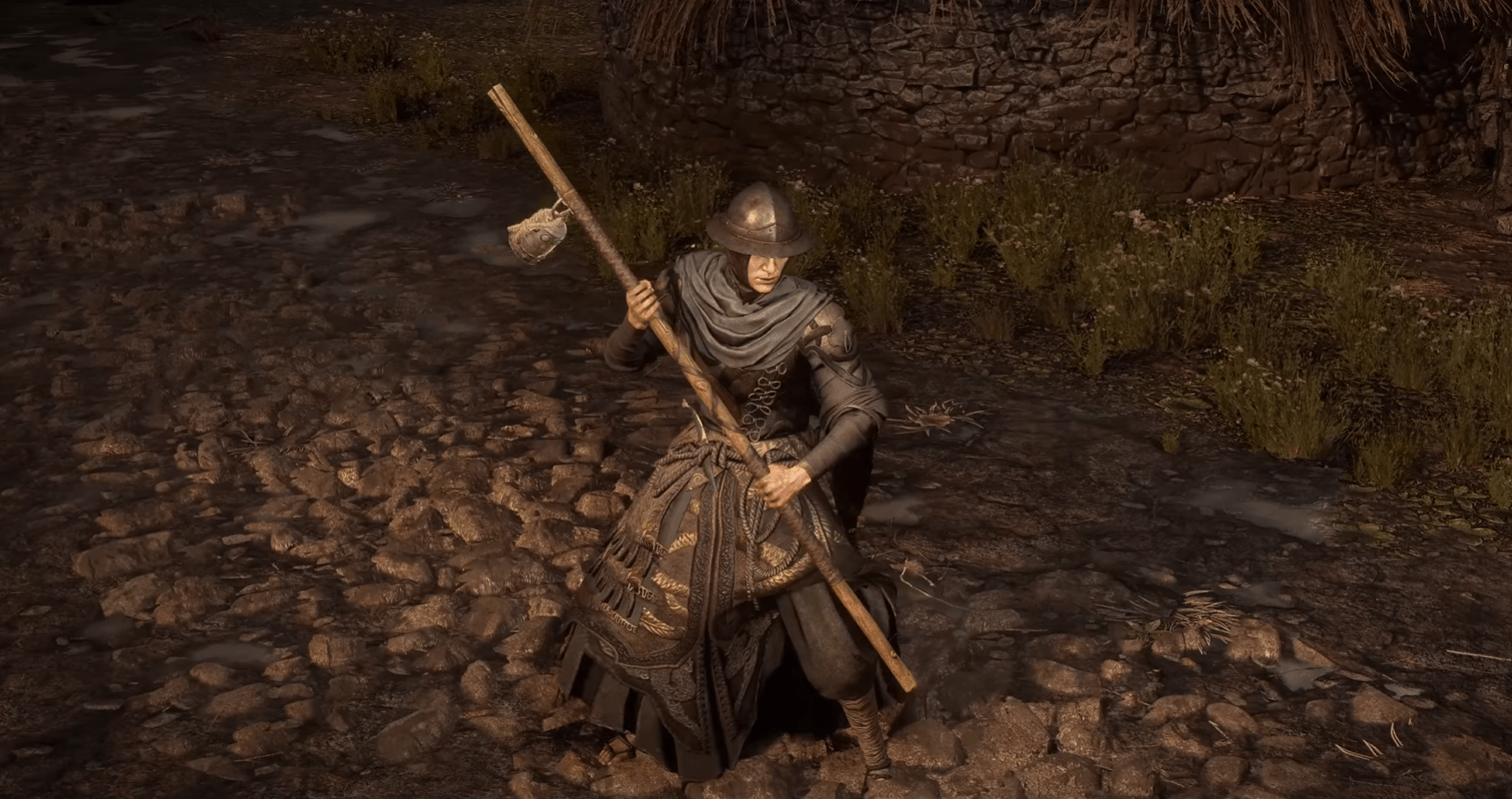
Monk’s favorite weapon type is a Quarterstaff. It comes with 20 skill gems and is a perfect match for the class, as Path of Exile 2 Monk weapons of this type are usually 75% Dexterity and 25% Intellect in terms of stat bonuses. So, in many ways, it’s a perfect match. All of the gameplay footage shown by the developers showcases the Monk class wielding some sort of Quarterstaff. We’ll explore its skills down below, but for now, what would be your second weapon choice?
Quarterstaff employs 3 schools of martial arts:
- Lightning
- Ice
- Wind
You can choose to specialize in one of them to unlock some of the most devastating skills or, better yet, combine all 3, mixing elements of them all.
The gameplay style of Quarterstaffs is exactly what we described earlier. It’s a mix of mid-range AoE attacks that always have some special properties, such as stuns, push-backs, or elemental powers. Then you have the true-melee attacks, like the 3-hit combo from the auto-attack. Every skill you use on a Quarterstaff doesn’t just lock you in an animation; you’re free to move around or redirect your attacks during the animation, which is extremely helpful. It also makes the combat feel lighter and more dynamic.
Of course, you can always double down and use another Quarterstaff with different bonuses and stats. Alternatively, you can adopt completely different weapon types, such as Daggers, as they’re 50% Dexterity and 50% Intellect in terms of Path of Exile 2 Monk stats and bonuses. Furthermore, you could go for a bow to add extra ranged attacks. Soften up your enemies or apply some status effects and then finish them off with your main Quarterstaff weapon - a viable tactic.
Or, you could go full Intellect-based weapon and pick one of the Staves as your secondary weapon. Staves all come with a built-in ranged auto-attack, but you could also use more element-based skill gems.
Another option that will help you a lot in the early game, in Act 1, is the crossbow. Crossbows have skills that allow you to shoot elemental bolts. This means that you can use a crossbow as your secondary to build up elemental damage from afar. For example, you can use the Permafrst Bolts that is a wide-cone AoE attack that builds up Freezing effect. Then you can finish your enemies off with the Quarterstaff's Glacial Cascade which is more effective when used against frozen enemies. On top of that, having a ranged weapon is really helpful when fighting bosses. Monk is a melee class and the only ranged attack that you have is the Glacial Cascade that doesn't do that much damage. Besides using Falling Thunder as a ranged option is only possible when you build up Charges which wouldn't be possible when you're fighting a boss. And since you can't tank boss' damage, your next best option is to switch to the crossbow and use it as your standard attack. Build up a meter to stagger the boss and then switch to your Quarterstaff's heavy-hitting melee skills while the boss can't move.
Monk Skill Gems
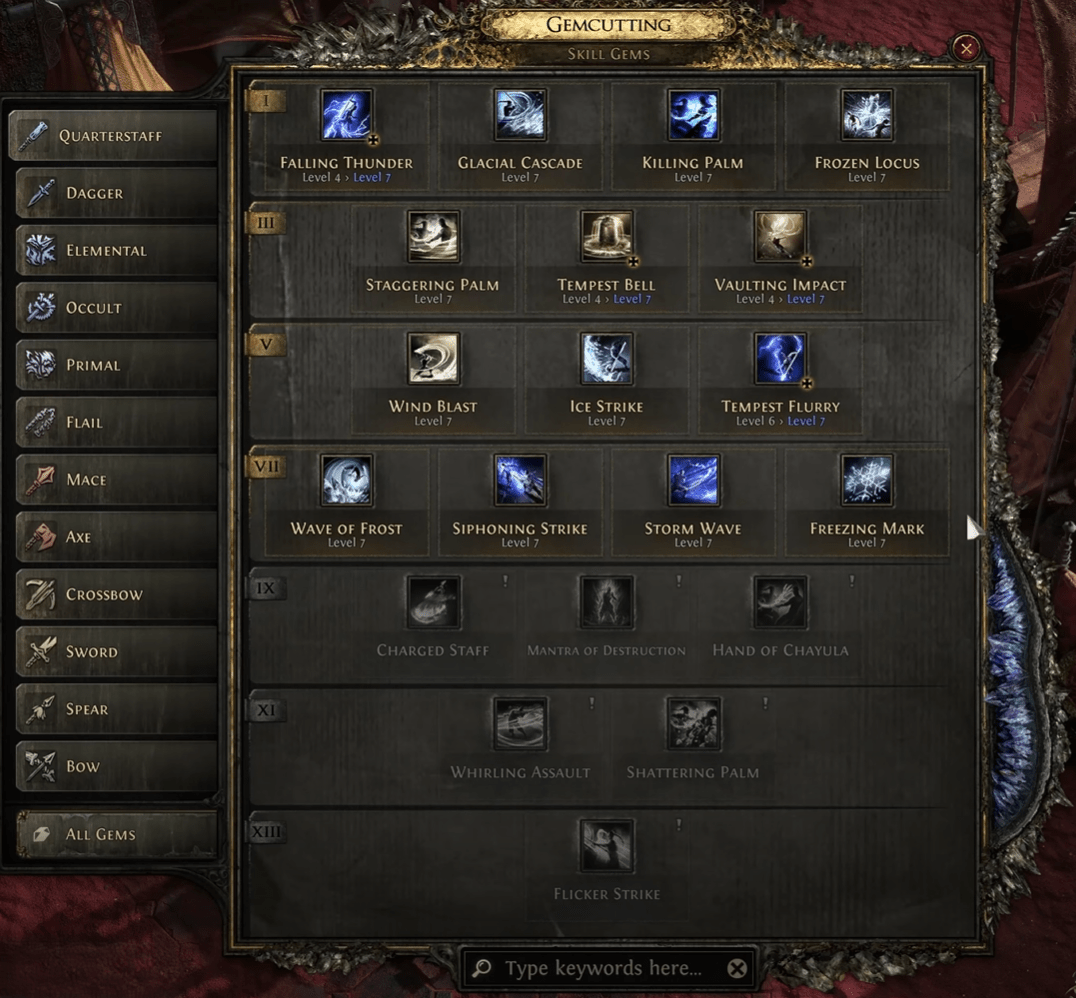
We’re going to be taking a look at Path of Exile 2 Monk skills, assuming that Monk is using a Quarterstaff, as this seems to be the class’ signature weapon type. We will list all of the skills for this weapon, but we will only talk about some of them in greater depth. We’ll highlight some cool combinations that you can use when playing with this weapon type.
- Falling Thunder – without a Power Charge, this skill creates a small lightning AoE in front of the character. When used with a Power Charge, it creates a much larger AoE, turning it into a true pack-clearer. As the character jumps up to slam the ground with the weapon, you can freely move or rotate to redirect the attack.
- Glacial Cascade – creates a wave of ice that moves slowly in front of a player. It deals the most amount of damage at the end of the travel path, so hitting immobile targets with it is the most effective way to use it.
- Killing Palm – can be used to take advantage of a specific situation quickly. It’s a dash and an unarmed attack that grants a Power Charge if you kill an enemy with it. Whenever an enemy has a blue mark above them, that enemy can be instantly killed with a Killing Palm to receive a Power Charge.
- Staggering Palm – an unarmed attack that buffs your weapon, causing your following attacks to shoot out wind projectiles
- Tempest Bell – places a giant resonating bell. Hitting the bell causes it to ring, damaging all the enemies around it. The bell can also be attacked with elemental attacks, causing it to spread these elemental effects to all the enemies in range.
- Wind Blast – a great option to shed off smaller enemies and their health without getting too close. It’s a ranged wind attack that hits enemies in a cone in front of the character. It also pushes enemies away. The closer the enemies, the farther they’re pushed back.
- Ice Strike – a melee attack that freezes enemies. It’s a 3-hit combo. If all 3 hits are landed on the same enemy, the final hit will freeze them.
- Whirling Assault – an AoE melee attack where you jump forward while hitting enemies around you. A perfect option to cull enemies before finishing them off to get a Power Charge.
- Shattering Palm – a palm strike that puts a small ice bomb on a target. Deal enough damage to the target, and the bomb will explode, causing damage and a significant freeze. It’s a good option to use in a boss fight when one freeze ability is not enough to proc the effect.
- Flicker Strike – consumes Power Charges. Teleports you from target to target landing hits on each. It’s a great finisher if you are able to get some Power Charges beforehand.
The main mechanic of this weapon is gaining a Power Charge through some of Path of Exile 2 Monk skill gems and then spending it on some other skills. Obviously, skills that consume Power Charges are more powerful than those that accumulate them. BLOG20
With that said, by the endgame, you will be dashing from pack to pack, spewing projectiles, and obliterating entire screens of enemies with huge combo attacks.
Best Early-Game Support Gems
Since all of your attacks are pretty slow and your main combo involves building up charges, you're going to want to address these things when unlocking support gems. Here are a few very helpful ones:
- Martial Tempo for Quarterstaff Strike (auto-attack) - increasing the default attack by 25% will help you lower enemies' health faster to use Killing Palm on them.
- Perpetual Charge for Falling Thunder - gives you a 35% chance to not remove charges, which is pretty sweet.
- Profusion for Killing Palm - gives you a 50%(!) chance to grant an additional charge. An extremely useful support gem that doubles the effectiveness of the Killing Palm. Sometimes it's really hard to get to enemies that can give you a charge.
- Cold Infusion for Glacial Cascade - gives +25% damage as extra Cold Damage. This one is a no-brainer.
- Overpower for Vaulting Impact - gives you 50% more Stun buildup, which is handy for this awesome skill.
In total, we have 3 Dexterity support gems, 1 Strength support gem and one Intellect support gems. This fits into the Support Gem Capacity perfectly leaving you some more free slots to experiment with other options.
Best Monk Rotation
This rotation incorporates the Monk’s mobility, power charge generation, and freezing mechanics, tailoring it to a quarterstaff playstyle. The quarterstaff would emphasize wide-reaching, impactful melee strikes with fluid repositioning and control. While these might not be the Path of Exile 2 Monk best gems, they make pretty effective combos.
- Whirling Assault - Engage enemies by closing the gap and positioning yourself effectively. Covers ground and deals chip damage.
- Killing Palm - Cull low-health enemies to generate power charges, setting up your power charge-dependent abilities.
- Falling Thunder - Clear enemy packs with a large AoE that becomes more effective when enhanced by power charges.
- Ice Strike - Perform a three-hit combo to freeze tougher enemies or bosses, preparing them for follow-up damage.
- Glacial Cascade - Target frozen enemies to deliver massive damage, especially with the spike at the end of the cascade.
- Wave of Frost - Retreat from dangerous situations while freezing enemies in front of you for control and spacing.
- Shattering Palm - Apply an ice bomb to high-health targets or bosses, causing it to explode and freeze nearby enemies.
- Flicker Strike - Use power charges for high burst damage, which is ideal for finishing off bosses or single targets.
Rotation Summary
- Engage:
- Start with Whirling Assault for positioning and initial damage.
- Control enemies with Wind Blast if needed.
- Generate Power Charges:
- Use Killing Palm to cull weakened enemies and build power charges.
- Deal Damage:
- Use Falling Thunder for AoE clearing.
- Apply Ice Strike to freeze tougher enemies.
- Follow with Glacial Cascade to maximize damage on frozen targets.
- Control and Reposition:
- Use Wave of Frost for retreat and freezing.
- Apply Shattering Palm for extra freezing or AoE burst.
- Boss Finisher:
- Use Flicker Strike for power charge-finishing attacks.
- Rely on dodge rolls to evade mechanics and maintain mobility.
Why This Works for Quarterstaff
- Wide Reach: The quarterstaff’s range complements skills like Falling Thunder and Whirling Assault, allowing for effective multi-target control.
- Mobility: The Monk’s built-in movement mechanics pair well with the fluid and dynamic nature of quarterstaff combat.
- Freeze and Control: Skills like Ice Strike, Glacial Cascade, and Shattering Palm shine in single-target or boss scenarios, allowing for calculated and impactful strikes.
The suggested rotation is crafted to maximize the Monk's unique mechanics, ensuring a balance between mobility, control, and devastating combos. Each step follows the natural flow of combat as outlined in the gameplay commentary, starting with engaging enemies, generating power charges, and delivering powerful follow-up attacks. This sequence is designed to feel fluid and responsive, allowing for both efficient clearing and impactful single-target damage.
Experimenting with the rotation in different scenarios—whether against packs or bosses—will help refine its execution. The flexibility of skills like Wave of Frost and Shattering Palm ensures adaptability, making this rotation a strong foundation for mastering the Monk's playstyle.
Monk Ascendancies
As we know, there are 3 Path of Exile 2 Monk Ascendancies, just like any other class in the game. But, for the early access of PoE 2 only two of them is available. Each Ascendancy class is unique, so you have to choose wisely as they will drastically affect how you build your character. Each Ascendancy class has its own passive skill tree with around 20 nodes to unlock.
Monk Ascendancy: Invoker
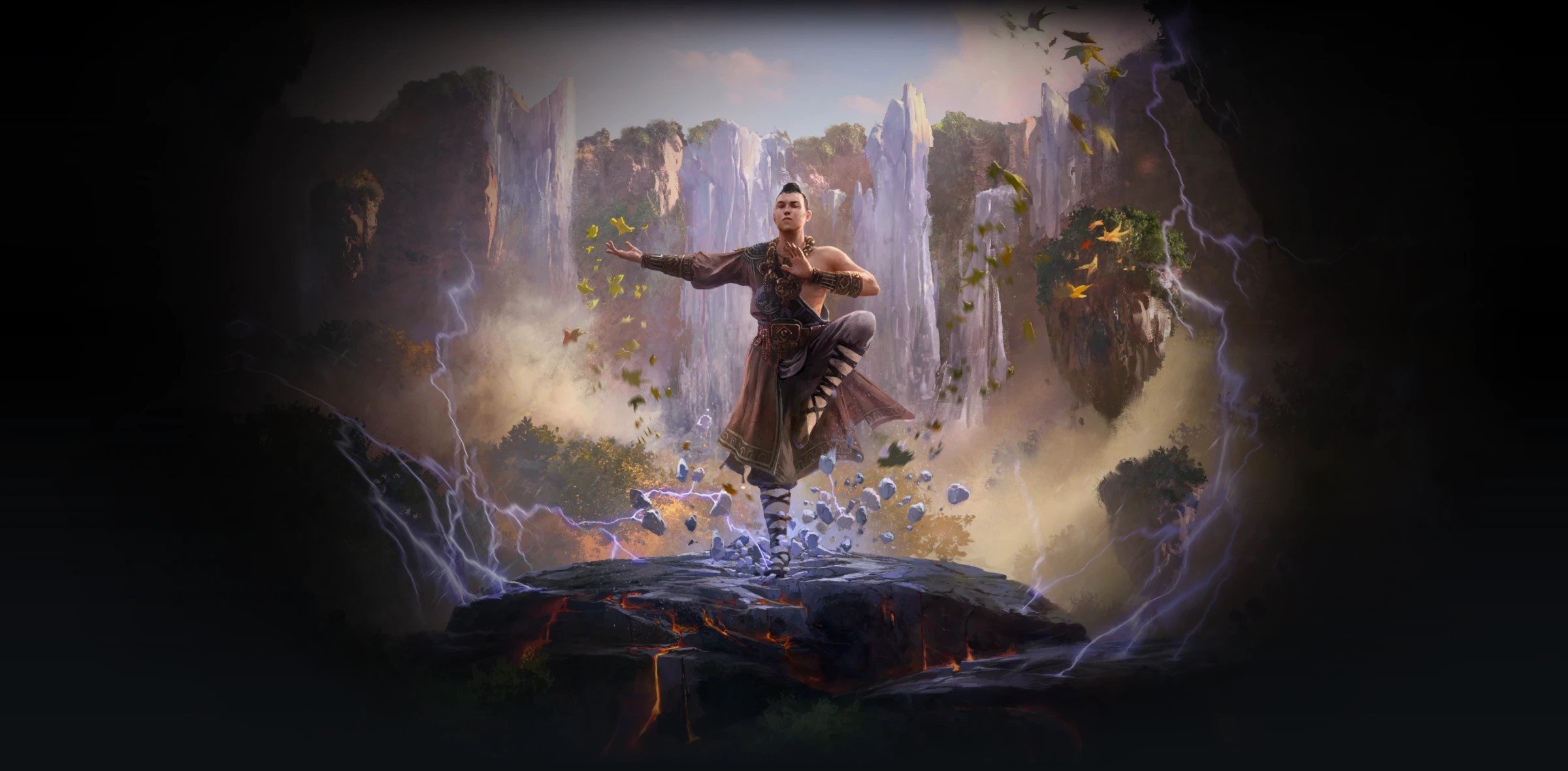
Invoker is the Ascendancy class for Monks who are in tune with the elements. Here are some passive skills from Inovkers own skill tree:
- Elemental Expression: Generates waves of elemental power (Cold or Lightning) upon landing a critical strike. This mechanic rewards precision and can devastate groups of enemies with area-of-effect elemental damage.
- Faith is a Choice: Grants a meditation ability that doubles your energy shield, offering a balance between offense and defense. This skill is perfect for situations requiring tanking or mitigation of large damage spikes.
- Specialization Nodes:
- I Am the Blizzard: Enhances Cold damage output, including freezing and slowing enemies.
- I Am the Thunder: Focuses on Lightning damage, emphasizing shock effects for additional damage multipliers.
- And I Shall Rage: Enables transformation into an Unbound Avatar, a powerful state achieved by accumulating Unbound Fury through applying status ailments to enemies. While in Avatar form, damage and status application are significantly amplified.
The Invoker’s playstyle revolves around creative combinations of elemental effects and building momentum for massive bursts of damage. It excels at clearing groups of enemies while maintaining survivability through energy shield boosts.
Monk Ascendancy: The Acolyte of Chayula
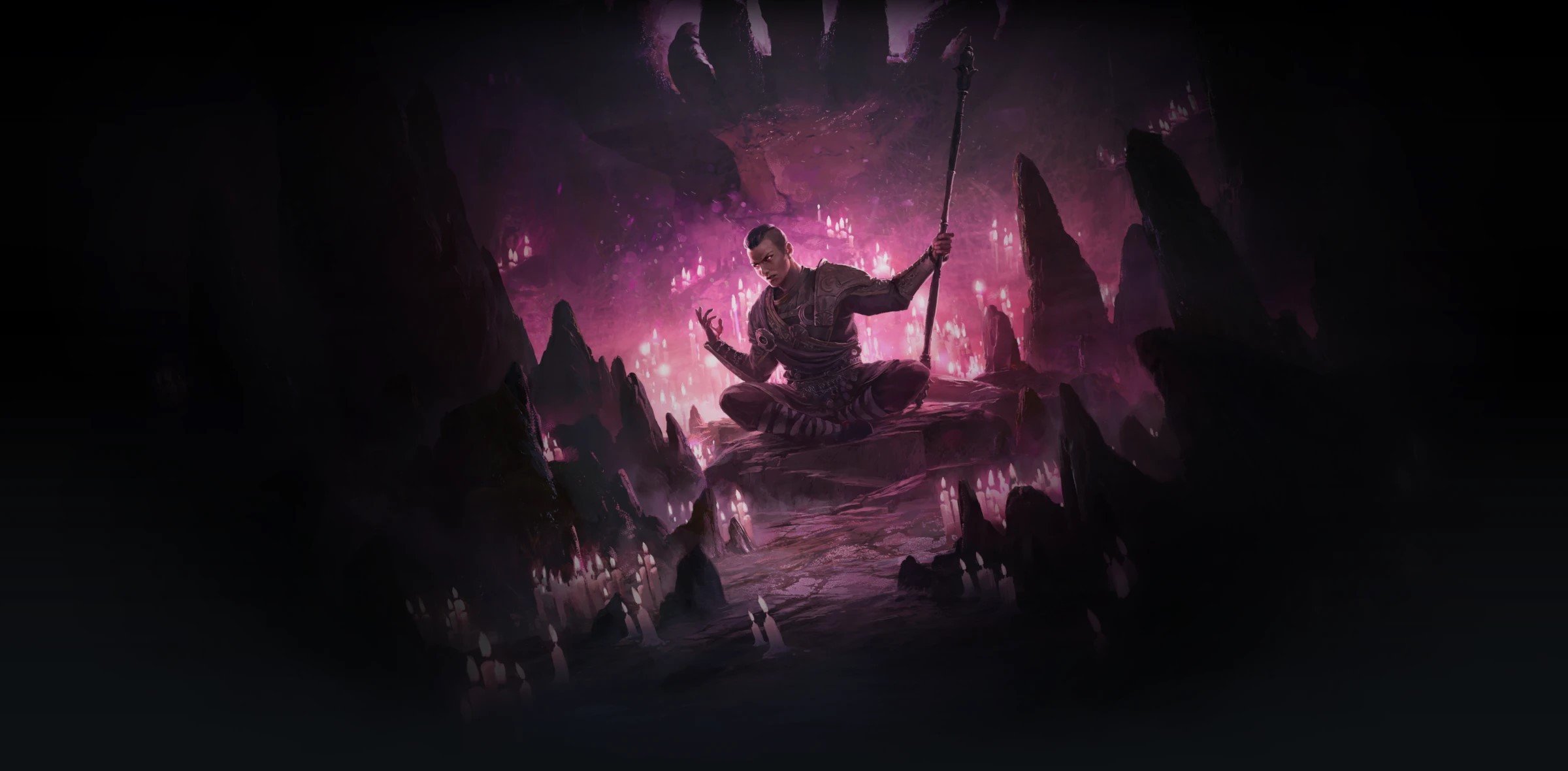
The Acolyte of Chayula is for Monks who prefer to tap into the power of darkness. Replace the Spirit resource with the Darkness resource. Darkness can be utilized to both absorb and deal damage.
- Shroud of Darkness: Protects the Acolyte from incoming damage by enveloping them in a shadowy barrier, perfect for mitigating burst damage in challenging encounters.
- Grasp of the Void: Converts stored Darkness into additional chaos damage, making every offensive move increasingly deadly as the fight progresses.
- Dark Pact: Offers massive chaos resistance and allows for instant mana leech, directly benefiting energy shield restoration. This significantly enhances sustainability in prolonged fights.
- Waking Dream: Grants access to the domain of Breach demons, where players can interact with the flames of Chayula. These flames provide bonuses to Life, Mana, and Damage, making it a high-risk, high-reward mechanic that encourages bold play.
The Acolyte of Chayula thrives in sustained battles where its unique Darkness resource can be fully utilized, offering high survivability and chaos damage scaling. Its thematic focus on Breach interactions ties it to some of the most powerful enemies and rewards in the game.
Monk Leveling
Note: this section of the guide is under development.
Path of Exile 2 Monk leveling process throughout the Early Access will involve you completing the first 3 Acts to reach level 45 on the Normal difficulty. Then you will have the option to complete the same acts one more time on a higher difficulty called “Cruel”. This difficulty will not just offer a more challenging walkthrough. You’ll also be able to earn more powerful items and, more importantly, reach level 65. When you finish the 3rd act for the second time and reach level 65, that’s when you’ll be able to set foot in the endgame.
Throughout the endgame, you’ll continue to level up your character all the way to level 100, refining your build and unlocking more nodes on the Atlas. The endgame’s design encourages you to choose the type of content that you want to do, so you’ll have plenty of agenda about what to do and how to play. But make no mistake – no matter what you do, PoE 2 Monk gameplay lvl 100 is going to be difficult. So, make sure you unlock all the right Passives. BLOG20
Early Game Hardships and What To Expect
Here's what you can expect from Monk as soon as you start the game. While Monk's fighting style involves fluid movement, martial arts like attacks and a lot of mobility, none of that will be available to you at the start. As soon as you findyourself in the first location, the Riverbank, and pick up your Quarterstaff, you'll be very slow. You'll have very slow basic attack, and a pretty slow role. On top of that, you're going to be taking so much damage, you'll have to pick up a habit of dodge-rolling away from every attack!
What you need to do as soon as you start getting Uncut Skill Gems and Uncut Support Skill Gems is determine your main combo of skills and stick to it. We're already talked about the rotation earlier, but your main combo during these first levels is this:
- Hit enemies with Quarterstaff Strike to get enemies to low health
- Use the Killing Palm to get a Charge. Charges last 20 seconds and preferably you need to get 2 or 3.
- Use Falling Thunder with 2 or 3 Charges to insta-kill packs of monsters
This is your main combo during your first hour of gameplay. You don't need to unlock any other level 1 skills. It will help you clear maps, advance through quests and even deal with first bosses. Use it!
Monk Best Builds
Note: this section of the guide is under development.
It’s way too early to talk about the Path of Exile 2 Monk best builds, and nobody else has any idea what the best builds are supposed to look like. One thing is for sure – making a good build is going to involve making the biggest decision for your class, which is choosing the Ascendancy class. Each of them has a widely different playstyle, and when you pick one, you can’t go back. In fact, you can unlock passives for each of the Ascendancy classes as long as you keep doing those trials. But a good build will require you to stick to one of them and unlock as many Path of Exile 2 Monk passives from the same Ascendancy as you can.
Monk Tips and Tricks
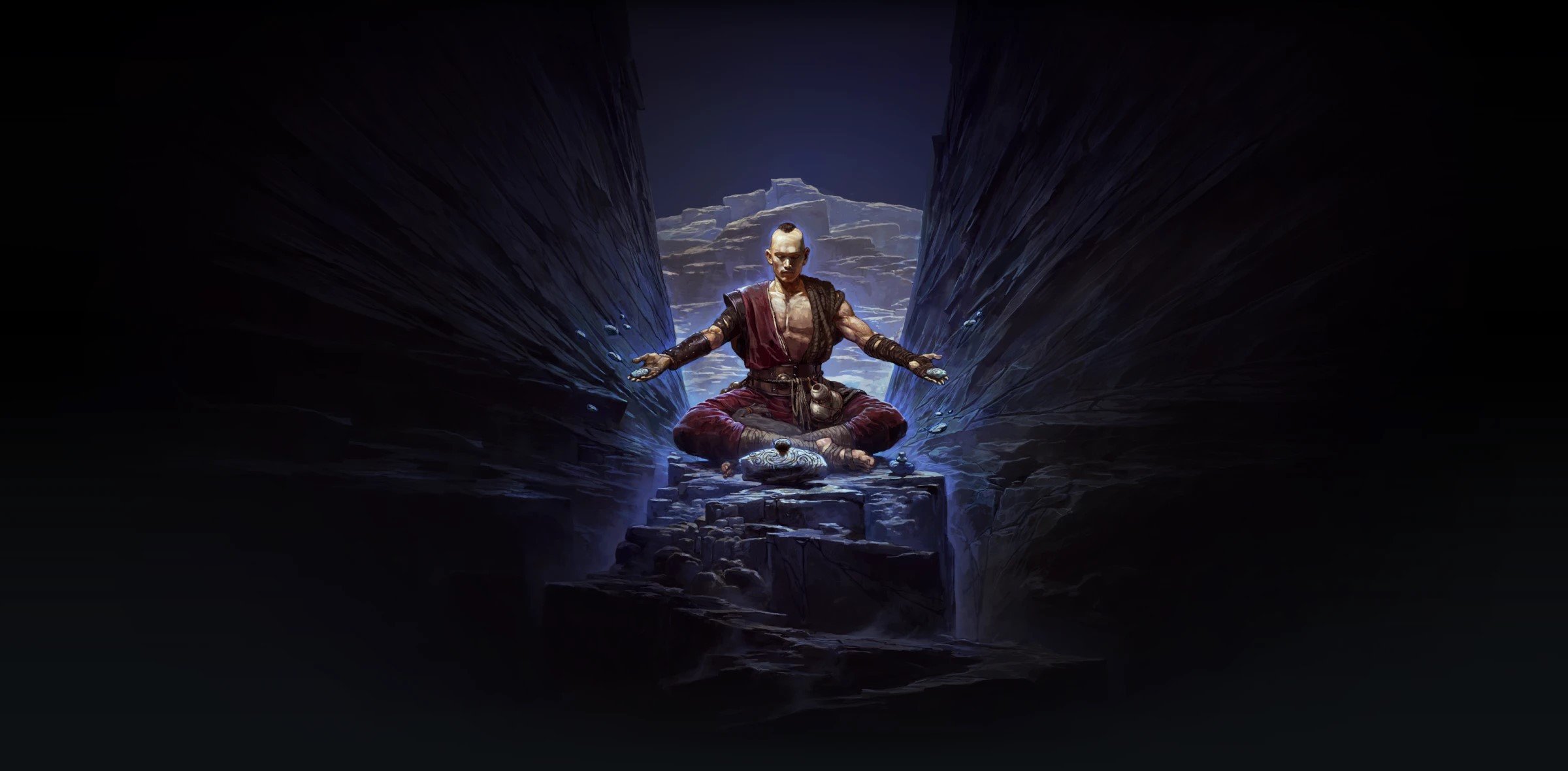
Monk is a highly mobile melee brawler. His fighting style requires precision and accuracy from you. We’d like to give you some good PoE 2 Monk tips that will help you get the most out of this class.
- Mix and Match Martial Arts Schools for Maximum Effect – The Monk utilizes three elemental schools: Lightning, Ice, and Wind. While it might seem intuitive to focus on one, the best combos arise from blending all three. For instance, you can use a Wind skill like Staggering Palm to stagger enemies, followed by an Ice skill like Glacial Cascade to freeze them, and finish with a Lightning skill for high-damage AoE. Experimenting with these combinations will yield powerful and versatile results.
- Power Charge Management is Key – Many Monk skills revolve around generating and consuming power charges. Use Killing Palm to efficiently cull low-health enemies and generate power charges. Follow up with skills like Tempest Bell or Falling Thunder to consume the charges for massive damage. Always ensure you're managing power charge generation effectively, as this will significantly amplify your damage potential in both single-target and AoE scenarios.
- Empower Your Quarterstaff with Elemental Skills and Combos – The Monk can empower their Quarterstaff through abilities like Staggering Palm, which sets up wind projectiles after staggering enemies. You can further enhance these effects by interacting with the environment or other elemental skills, such as freezing or shocking the Tempest Bell. Mastering these interactions will make your quarterstaff not just a weapon but a tool of elemental devastation.
These tips align with the Monk’s fast-paced, momentum-based playstyle and will help you maximize efficiency and adaptability in both campaign and endgame scenarios. Let me know if you'd like more specifics!
Conclusion
The Monk class in Path of Exile 2 offers a thrilling blend of agility, elemental mastery, and strategic combat. By leveraging its fast-paced playstyle, dynamic power charge mechanics, and the versatility of quarterstaff skills, players can create devastating combos that excel in both crowd control and single-target encounters. Success as a Monk requires balancing offense and mobility while creatively mixing the three elemental schools—Lightning, Ice, and Wind—for optimal synergy.
Whether you’re dashing between packs with Killing Palm, unleashing massive AoE through Tempest Bell, or freezing foes to amplify Glacial Cascade, the Monk rewards precision, adaptability, and experimentation. With its unique toolkit and satisfying gameplay mechanics, the Monk stands out as a versatile and rewarding class for players who love action-packed melee combat with a touch of finesse. Master the art of momentum, and you’ll find the Monk to be a powerful and exhilarating force in Wraeclast. Good luck, Exile, and may your journey be swift and triumphant!
You might want to check out our hottest Destiny 2 offers, such as Kell's Fall Exotic Mission and Slayer's Fang to skip the grind and get ahead of others.
F.A.Q.
Is Monk good in Path of Exile 2?
Yes, the Monk is an excellent class in Path of Exile 2 for players who enjoy fast-paced melee combat with high mobility. Its power-charge mechanics and versatility in combining elemental schools make it both fun and effective in clearing packs and taking down bosses.
What is the best Monk build in Path of Exile 2?
The best Monk builds often combine all three elemental schools—Lightning, Ice, and Wind—for maximum versatility. A popular build includes Killing Palm for power charge generation, Falling Thunder for AoE, and Glacial Cascade for burst damage against frozen enemies.
What does Monk do in Path of Exile 2?
The Monk is a fast and agile melee class that specializes in momentum-based combat. It excels at dashing between enemies, generating power charges, and unleashing devastating elemental combos using its quarterstaff.
What stats should a Monk have in PoE 2?
Monks benefit most from Dexterity and Intelligence, as these attributes enhance their mobility, critical strike chance, and elemental damage. Prioritize stats that improve attack speed, critical strikes, elemental damage, and energy shield.
What are the best skill gems for Monk PoE 2?
Some of the best skill gems for the Monk include Killing Palm for generating power charges, Falling Thunder for AoE damage, and Glacial Cascade for high single-target burst damage. Additionally, Tempest Bell and Staggering Palm are great for utility and control.
Is Monk good for fast leveling in PoE 2?
Yes, the Monk is highly efficient for fast leveling due to its high mobility and ability to clear packs quickly with AoE skills like Falling Thunder. Its power-charge mechanics also make it easier to transition to stronger abilities as it progresses.
What weapon should Monk use in Path of Exile 2?
The Monk primarily uses a quarterstaff, which synergizes with its skills and elemental damage bonuses. Quarterstaffs also enhance the Monk’s ability to stagger enemies and unleash elemental projectiles.
What are the best skills for Monk in PoE 2?
The best skills for the Monk include Killing Palm for power charge generation, Falling Thunder for AoE clearing, Glacial Cascade for burst damage, and Wave of Frost for retreat and control. Staggering Palm and Tempest Bell also provide strong utility and combo potential.








